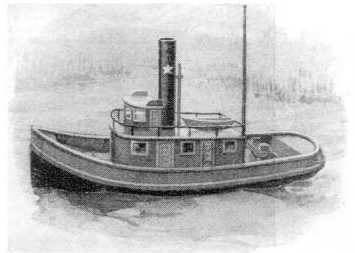|
Dick Hixon

THIS realistic little tugboat is driven by the simplest of all power plants —
a rubber band motor. It is, there-fore, easy to build and inexpensive.
Careful painting makes the little boat look more like a real model than a toy.
Clear white pine is the best material for the hull, although any other soft, close
grained wood will do. Shape the hull as shown from a block 1 1/8 by 4 by 15 in. and
hollow out the inside for buoyancy as in Fig. 2. Turn the hull upside down on a
3/8 in. thick piece of wood and mark around it. Saw out the deck thus marked,
but keep 1/8 in. within the outline every-where except at the very stern, as shown
in Fig. 3. Then, when the deck has been nailed in place, there will be a natural
rabbet or recess into which the bulwarks can be fastened.
The forward ends of the bulwarks can be steamed or soaked in boiling water
until the wood bends easily. Before fastening on the bulwarks, however,
build up the bow and stern with blocks shaped as shown in Fig. 3. A piece of tin
or sheet copper is fastened over the joint of the bulwarks at the bow and a 1/8 in.
square molding of cardboard or wood is applied to cover the joint between the
bulwarks and the hull.
A rail is made for the top of the bulwarks by sawing out one wishbone-shaped
piece of heavy cardboard or thin wood and another semicircular piece for the
bow and stern portions respectively; straight strips are used for the sections
between. The superstructure and-fittings are made as shown in the illustrations,
which are very nearly self-explanatory.
Bore a hole at the stern at a slight angle as indicated to receive the 1/2-in. dowel
stick for the propeller support, which should be forced in tightly.
Attach a keel made from a scrap of lead obtained at a plumber's shop. Have the
keel too large to begin with and cut it down until the boat floats properly.
Make a wooden rudder and fasten it to the hull. Cut the propeller from tin,
galvanized iron or sheet copper and solder it on a length of stiff
brass wire. Bend one end into a crank for winding and
the other into a hook to hold the rubber bands. A nut
from a dry battery will serve as a washer. Strands of
rubber such as are sold for airplane models are the best
source of power, but heavy rubber bands bought at a
stationery shop will serve the purpose.
The effectiveness of this toy depends largely upon the
painting (Fig. 1). The hull may be black and green,
black and vermilion, or all black; the cabin or pilot
house, green or vermilion with white, black and gray
trimmings; the funnel, black with a white star on each
side and perhaps a red or green band with orange or
gold stripes at the top. Give the entire boat a coat of spar
varnish, and, if you can letter well, paint a name on the
stern in bronze or orange.
|